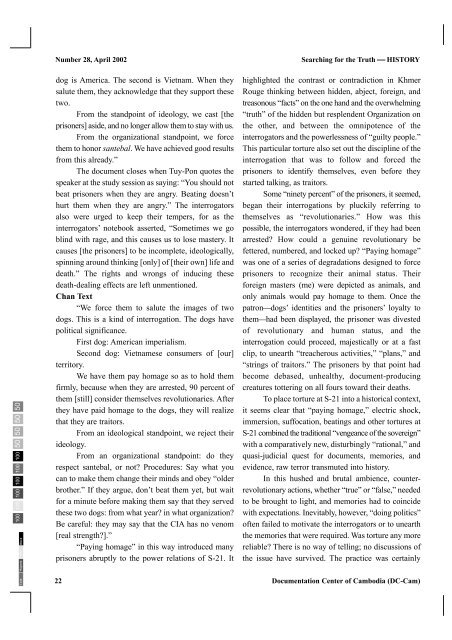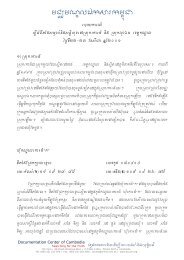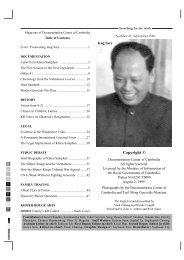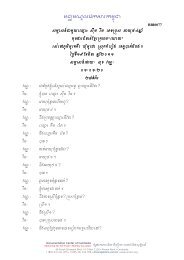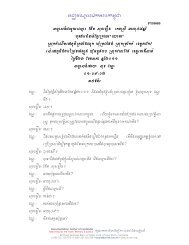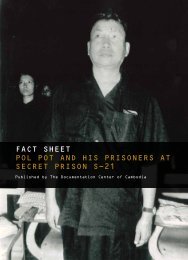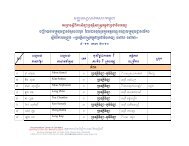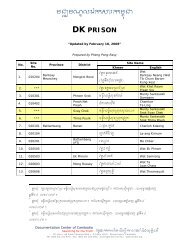Searching for the truth Issues 28 - Documentation Center of Cambodia
Searching for the truth Issues 28 - Documentation Center of Cambodia
Searching for the truth Issues 28 - Documentation Center of Cambodia
You also want an ePaper? Increase the reach of your titles
YUMPU automatically turns print PDFs into web optimized ePapers that Google loves.
100 100 100 100 100 100 50 50 50 50<br />
Black<br />
Yellow<br />
Magenta<br />
Cyan<br />
Number <strong>28</strong>, April 2002<br />
dog is America. The second is Vietnam. When <strong>the</strong>y<br />
salute <strong>the</strong>m, <strong>the</strong>y acknowledge that <strong>the</strong>y support <strong>the</strong>se<br />
two.<br />
From <strong>the</strong> standpoint <strong>of</strong> ideology, we cast [<strong>the</strong><br />
prisoners] aside, and no longer allow <strong>the</strong>m to stay with us.<br />
From <strong>the</strong> organizational standpoint, we <strong>for</strong>ce<br />
<strong>the</strong>m to honor santebal. We have achieved good results<br />
from this already.”<br />
The document closes when Tuy-Pon quotes <strong>the</strong><br />
speaker at <strong>the</strong> study session as saying: “You should not<br />
beat prisoners when <strong>the</strong>y are angry. Beating doesn’t<br />
hurt <strong>the</strong>m when <strong>the</strong>y are angry.” The interrogators<br />
also were urged to keep <strong>the</strong>ir tempers, <strong>for</strong> as <strong>the</strong><br />
interrogators’ notebook asserted, “Sometimes we go<br />
blind with rage, and this causes us to lose mastery. It<br />
causes [<strong>the</strong> prisoners] to be incomplete, ideologically,<br />
spinning around thinking [only] <strong>of</strong> [<strong>the</strong>ir own] life and<br />
death.” The rights and wrongs <strong>of</strong> inducing <strong>the</strong>se<br />
death-dealing effects are left unmentioned.<br />
Chan Text<br />
“We <strong>for</strong>ce <strong>the</strong>m to salute <strong>the</strong> images <strong>of</strong> two<br />
dogs. This is a kind <strong>of</strong> interrogation. The dogs have<br />
political significance.<br />
First dog: American imperialism.<br />
Second dog: Vietnamese consumers <strong>of</strong> [our]<br />
territory.<br />
We have <strong>the</strong>m pay homage so as to hold <strong>the</strong>m<br />
firmly, because when <strong>the</strong>y are arrested, 90 percent <strong>of</strong><br />
<strong>the</strong>m [still] consider <strong>the</strong>mselves revolutionaries. After<br />
<strong>the</strong>y have paid homage to <strong>the</strong> dogs, <strong>the</strong>y will realize<br />
that <strong>the</strong>y are traitors.<br />
From an ideological standpoint, we reject <strong>the</strong>ir<br />
ideology.<br />
From an organizational standpoint: do <strong>the</strong>y<br />
respect santebal, or not? Procedures: Say what you<br />
can to make <strong>the</strong>m change <strong>the</strong>ir minds and obey “older<br />
bro<strong>the</strong>r.” If <strong>the</strong>y argue, don’t beat <strong>the</strong>m yet, but wait<br />
<strong>for</strong> a minute be<strong>for</strong>e making <strong>the</strong>m say that <strong>the</strong>y served<br />
<strong>the</strong>se two dogs: from what year? in what organization?<br />
Be careful: <strong>the</strong>y may say that <strong>the</strong> CIA has no venom<br />
[real strength?].”<br />
“Paying homage” in this way introduced many<br />
prisoners abruptly to <strong>the</strong> power relations <strong>of</strong> S-21. It<br />
22<br />
<strong>Searching</strong> <strong>for</strong> <strong>the</strong> Truth ⎯ HISTORY<br />
highlighted <strong>the</strong> contrast or contradiction in Khmer<br />
Rouge thinking between hidden, abject, <strong>for</strong>eign, and<br />
treasonous “facts” on <strong>the</strong> one hand and <strong>the</strong> overwhelming<br />
“<strong>truth</strong>” <strong>of</strong> <strong>the</strong> hidden but resplendent Organization on<br />
<strong>the</strong> o<strong>the</strong>r, and between <strong>the</strong> omnipotence <strong>of</strong> <strong>the</strong><br />
interrogators and <strong>the</strong> powerlessness <strong>of</strong> “guilty people.”<br />
This particular torture also set out <strong>the</strong> discipline <strong>of</strong> <strong>the</strong><br />
interrogation that was to follow and <strong>for</strong>ced <strong>the</strong><br />
prisoners to identify <strong>the</strong>mselves, even be<strong>for</strong>e <strong>the</strong>y<br />
started talking, as traitors.<br />
Some “ninety percent” <strong>of</strong> <strong>the</strong> prisoners, it seemed,<br />
began <strong>the</strong>ir interrogations by pluckily referring to<br />
<strong>the</strong>mselves as “revolutionaries.” How was this<br />
possible, <strong>the</strong> interrogators wondered, if <strong>the</strong>y had been<br />
arrested? How could a genuine revolutionary be<br />
fettered, numbered, and locked up? “Paying homage”<br />
was one <strong>of</strong> a series <strong>of</strong> degradations designed to <strong>for</strong>ce<br />
prisoners to recognize <strong>the</strong>ir animal status. Their<br />
<strong>for</strong>eign masters (me) were depicted as animals, and<br />
only animals would pay homage to <strong>the</strong>m. Once <strong>the</strong><br />
patron⎯dogs’ identities and <strong>the</strong> prisoners’ loyalty to<br />
<strong>the</strong>m⎯had been displayed, <strong>the</strong> prisoner was divested<br />
<strong>of</strong> revolutionary and human status, and <strong>the</strong><br />
interrogation could proceed, majestically or at a fast<br />
clip, to unearth “treacherous activities,” “plans,” and<br />
“strings <strong>of</strong> traitors.” The prisoners by that point had<br />
become debased, unhealthy, document-producing<br />
creatures tottering on all fours toward <strong>the</strong>ir deaths.<br />
To place torture at S-21 into a historical context,<br />
it seems clear that “paying homage,” electric shock,<br />
immersion, suffocation, beatings and o<strong>the</strong>r tortures at<br />
S-21 combined <strong>the</strong> traditional “vengeance <strong>of</strong> <strong>the</strong> sovereign”<br />
with a comparatively new, disturbingly “rational,” and<br />
quasi-judicial quest <strong>for</strong> documents, memories, and<br />
evidence, raw terror transmuted into history.<br />
In this hushed and brutal ambience, counterrevolutionary<br />
actions, whe<strong>the</strong>r “true” or “false,” needed<br />
to be brought to light, and memories had to coincide<br />
with expectations. Inevitably, however, “doing politics”<br />
<strong>of</strong>ten failed to motivate <strong>the</strong> interrogators or to unearth<br />
<strong>the</strong> memories that were required. Was torture any more<br />
reliable? There is no way <strong>of</strong> telling; no discussions <strong>of</strong><br />
<strong>the</strong> issue have survived. The practice was certainly<br />
<strong>Documentation</strong> <strong>Center</strong> <strong>of</strong> <strong>Cambodia</strong> (DC-Cam)


